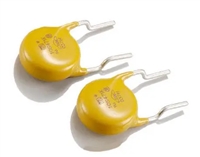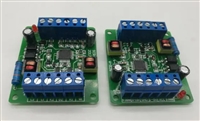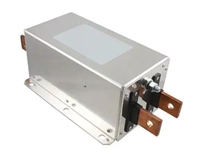AD630
desired signal multiplied by the low frequency gain (which may
be several hundred for large feedback ratios) with the switching
signal and interference superimposed at unity gain.
The collectors of each switching cell connect to an input trans-
conductance stage. The selected cell conveys bias currents i22
and i23 to the input stage it controls, causing it to become active.
The deselected cell blocks the bias to its input stage which, as a
consequence, remains off.
C
C
2k⍀
10k⍀
2k⍀
The structure of the transconductance stages is such that they
present a high impedance at their input terminals and draw no
bias current when deselected. The deselected input does not
interfere with the operation of the selected input insuring maxi-
mum channel separation.
100k⍀
V
i
2
A
B
20
13
V
O
19
18
12
11.11k⍀
Another feature of the input structure is that it enhances the
slew rate of the circuit. The current output of the active
stage follows a quasi-hyperbolic-sine relationship to the dif-
ferential input voltage. This means that the greater the input
voltage, the harder this stage will drive the output integrator,
and hence, the faster the output signal will move. This feature
helps insure rapid, symmetric settling when switching between
inverting and noninverting closed loop configurations.
7
9
10
8
–V
S
Figure 6. AD630 with External Feedback
SWITCHED INPUT IMPEDANCE
The noninverting mode of operation is a high input impedance
configuration while the inverting mode is a low input impedance
configuration. This means that the input impedance of the
circuit undergoes an abrupt change as the gain is switched
under control of the comparator. If gain is switched when the
input signal is not zero, as it is in many practical cases, a tran-
sient will be delivered to the circuitry driving the AD630. In
most applications, this will require the AD630 circuit to be
driven by a low impedance source which remains “stiff” at high
frequencies. Generally this will be a wideband buffer amplifier.
The output section of the AD630 includes a current mirror-
load (Q24 and Q25), an integrator-voltage gain stage (Q32),
and complementary output buffer (Q44 and Q74). The outputs of
both transconductance stages are connected in parallel to the
current mirror. Since the deselected input stage produces no
output current and presents a high impedance at its outputs,
there is no conflict. The current mirror translates the differen-
tial output current from the active input transconductance
amplifier into single ended form for the output integrator. The
complementary output driver then buffers the integrator output
produce a low impedance output.
FREQUENCY COMPENSATION
The AD630 combines the convenience of internal frequency
compensation with the flexibility of external compensation by
means of an optional self-contained compensation capacitor.
OTHER GAIN CONFIGURATIONS
Many applications require switched gains other than the 1 and
2 which the self-contained applications resistors provide. The
AD630 can be readily programmed with three external resistors
over a wide range of positive and negative gain by selecting and
RB and RF to give the noninverting gain 1 + RF/RB and subsequent
RA to give the desired inverting gain. Note that when the inverting
magnitude equals the noninverting magnitude, the value of RA is
found to be RB RF/(RB + RF). That is, RA should equal the parallel
combination of RB and RF to match positive and negative gain.
In gain of 2 applications the noise gain which must be addressed
for stability purposes is actually 4. In this circumstance, the
phase margin of the loop will be on the order of 60° without the
optional compensation. This condition provides the maximum
bandwidth and slew-rate for closed-loop gains of |2| and above.
When the AD630 is used as a multiplexer, or in other configura-
tions where one or both inputs are connected for unity gain
feedback, the phase margin will be reduced to less than 20°.
This may be acceptable in applications where fast slewing is a
first priority, but the transient response will not be optimum.
For these applications, the self-contained compensation capacitor
may be added by connecting Pin 12 to Pin 13. This connection
reduces the closed loop bandwidth somewhat, and improves the
phase margin.
The feedback synthesis of the AD630 may also include reactive
impedance. The gain magnitudes will match at all frequencies if
the A impedance is made to equal the parallel combination of
the B and F impedances. Essentially the same considerations
apply to the AD630 as to conventional op-amp feedback circuits.
Virtually any function which can be realized with simple nonin-
verting “L network” feedback can be used with the AD630.
A common arrangement is shown in Figure 6. The low fre-
quency gain of this circuit is 10. The response will have a pole
(–3 dB) at a frequency f Ӎ 1/(2 π 100 kΩC) and a zero (3 dB
from the high frequency asymptote) at about 10 times this
frequency. The 2 kΩ resistor in series with each capacitor mitigates
the loading effect on circuitry driving this circuit, eliminates stabil-
ity problems, and has a minor effect on the pole-zero locations.
For intermediate conditions, such as gain of 1 where loop
attenuation is 2, use of the compensation should be determined
by whether bandwidth or settling response must be optimized.
The optional compensation should also be used when the AD630
is driving capacitive loads or whenever conservative frequency
compensation is desired.
OFFSET VOLTAGE NULLING
As a result of the reactive feedback, the high frequency com-
ponents of the switched input signal will be transmitted at
unity gain while the low frequency components will be ampli-
fied. This arrangement is useful in demodulators and lock-in
amplifiers. It increases the circuit dynamic range when the
modulation or interference is substantially larger than the
desired signal amplitude. The output signal will contain the
The offset voltages of both input stages and the comparator
have been pretrimmed so that external trimming will only be
required in the most demanding applications. The offset adjust-
ment of the two input channels is accomplished by means of a
differential and common-mode scheme. This facilitates fine
adjustment of system errors in switched gain applications. With
REV. D
–7–






 一文带你了解压敏电阻器在直流电路中的过压保护作用
一文带你了解压敏电阻器在直流电路中的过压保护作用

 可控硅触发板选型指南
可控硅触发板选型指南

 蓝白可调电位器的原理与使用特点解析
蓝白可调电位器的原理与使用特点解析

 网络滤波器、EMI滤波器与EMC滤波器:分类关系与功能详解
网络滤波器、EMI滤波器与EMC滤波器:分类关系与功能详解
